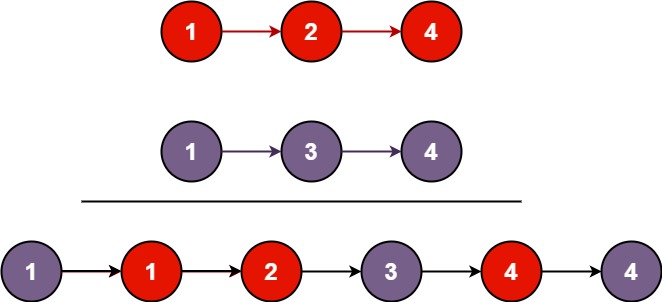将两个升序链表合并为一个新的 升序 链表并返回。新链表是通过拼接给定的两个链表的所有节点组成的。
示例 1:

输入:l1 = [1,2,4], l2 = [1,3,4]
输出:[1,1,2,3,4,4]
示例 2:
输入:l1 = [], l2 = []
输出:[]
示例 3:
输入:l1 = [], l2 = [0]
输出:[0]
提示:
- 两个链表的节点数目范围是
[0, 50]
-100 <= node.val <="100l1 和 l2 均按 非递减顺序 排列
非递归
增加一个节点
1
2
3
4
5
6
7
8
9
10
11
12
13
14
15
16
17
18
19
20
21
22
23
|
class Solution:
def mergeTwoLists(self, list1: Optional[ListNode], list2: Optional[ListNode]) -> Optional[ListNode]:
head = ListNode()
p = head
while list1 and list2:
if list1.val <= list2.val:
p.next = list1
p = p.next
list1 = list1.next
else:
p.next = list2
p = p.next
list2 = list2.next
if not list1:
p.next = list2
else:
p.next = list1
return head.next
|
list2插入list1
1
2
3
4
5
6
7
8
9
10
11
12
13
14
15
16
17
18
19
20
21
22
23
24
|
class Solution:
def mergeTwoLists(self, list1: Optional[ListNode], list2: Optional[ListNode]) -> Optional[ListNode]:
"""执行用时:44 ms, 在所有 Python3 提交中击败了43.43%的用户
内存消耗:15.1 MB, 在所有 Python3 提交中击败了22.66%的用户"""
p = ListNode(0,None)
p.next = list1
q = p
while list1 is not None and list2 is not None:
if list1.val > list2.val:
q.next = ListNode(list2.val,list1)
list2 = list2.next
q = q.next
else:
q = q.next
list1 = list1.next
if list1 is None:
q.next = list2
return p.next
|
递归
1
2
3
4
5
6
7
8
9
10
11
12
13
14
15
16
17
18
19
20
21
22
23
24
|
class Solution:
def mergeTwoLists(self, list1: Optional[ListNode], list2: Optional[ListNode]) -> Optional[ListNode]:
"""
执行用时:32 ms, 在所有 Python3 提交中击败了96.98%的用户
内存消耗:15.3 MB, 在所有 Python3 提交中击败了5.12%的用户
"""
if list1 is None:
return list2
elif list2 is None:
return list1
else:
if list1.val < list2.val:
list1.next = self.mergeTwoLists(list1.next,list2)
return list1
else:
list2.next = self.mergeTwoLists(list1,list2.next)
return list2
|
